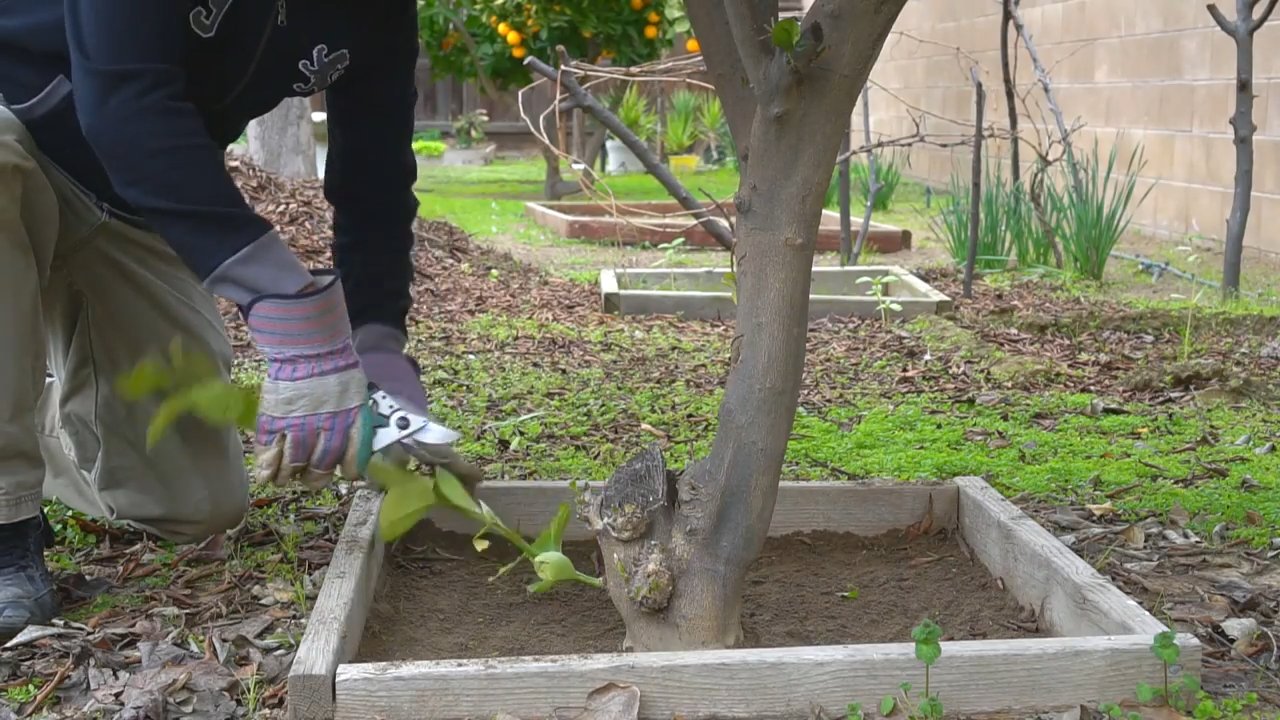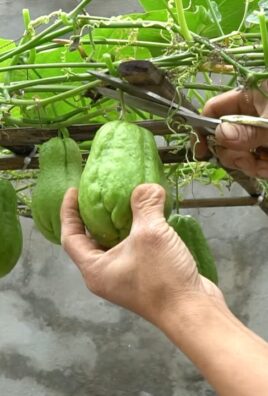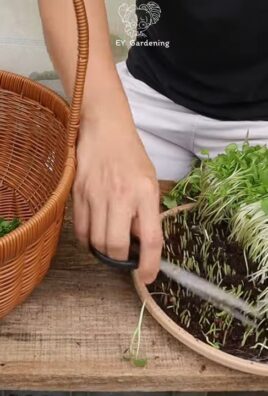Grow Oranges Indoors? Absolutely! Imagine plucking a sun-kissed, juicy orange straight from a tree thriving in your living room. Sounds like a tropical dream, right? Well, it’s more attainable than you might think! For centuries, cultivating citrus in controlled environments has been a mark of luxury and horticultural skill, dating back to the elaborate orangeries of European royalty. These structures allowed the wealthy to enjoy fresh citrus fruits year-round, regardless of the harsh climates outside.
Today, you don’t need a sprawling estate to experience the joy of homegrown oranges. Whether you live in a chilly northern climate or simply lack outdoor space, this DIY guide will empower you to successfully grow oranges indoors. I’ll share my tried-and-true tips and tricks, demystifying the process and making it accessible to even the most novice gardener.
Why bother with the effort? Because nothing beats the flavor of a freshly picked orange, bursting with sunshine and vitamins. Plus, nurturing a citrus tree indoors is incredibly rewarding, adding a touch of vibrant greenery and a delightful fragrance to your home. So, let’s ditch the store-bought fruit and embark on this exciting journey to cultivate your own indoor citrus oasis!

Growing Oranges Yourself: Your Guide for Indoor Cultivation
Hey plant friends! Have you ever dreamed of harvesting your own juicy oranges, right in the middle of winter, directly in your living room? Sounds crazy, right? But it’s absolutely doable! I’ll show you how you can successfully grow oranges indoors. It’s a bit of work, but the taste of a homegrown orange is simply unbeatable. So, let’s roll up our sleeves and get started!
What You Need: The Right Equipment
Before we get started, let’s make sure you have everything you need. Here is a list of the most important items:
- Orange tree seedling: You can either buy a young orange tree from a nursery or grow one from a seed of an organic orange (more on that later!). Be sure to choose a variety that is suitable for growing in pots, such as Calamondin, Meyer Lemon (although not an orange, very similar and easy to care for), or Kumquat.
- Large pot: Choose a pot with a diameter of at least 30 cm (12 inches) and good drainage. Orange trees need space to grow.
- High-quality potting soil: Use a well-draining potting soil specifically designed for citrus plants. Regular potting soil can lead to waterlogging.
- Organic fertilizer for citrus plants: Orange trees are hungry! A good fertilizer is crucial for a bountiful harvest.
- Spray bottle: For regularly moistening the leaves.
- Pruning tool: A sharp pair of garden shears or a knife to remove dead branches.
- Grow light (optional): If your location doesn’t provide enough sunlight.
- Gravel or clay shards: For drainage in the pot.
- Patience: Orange trees take time to grow and bear fruit.
Growing an Orange Tree from a Seed: A Challenge (but worth it!)
If you’re feeling adventurous, you can try to grow an orange tree from a seed. It takes longer for it to bear fruit (often several years), and the fruit may not be exactly like that of the parent plant, but it’s an exciting project!
- Prepare the seeds: Choose seeds from a ripe, organic orange. Rinse them thoroughly and let them dry for a few days.
- Stratification (optional, but recommended): Wrap the seeds in a damp paper towel and place them in the refrigerator for 30-60 days. This simulates winter and helps promote germination.
- Sowing: Fill small pots with seed-starting mix and sow the seeds about 1 cm (0.4 inches) deep.
- Moisture: Keep the soil moist, but not wet. Spray it regularly with water.
- Warmth and light: Place the pots in a warm, bright location.
- Patience: It can take several weeks or even months for the seeds to germinate.
- Transplanting: Once the seedlings are large enough (about 10-15 cm / 4-6 inches high), you can transplant them into larger pots.
The Right Location: Light, Warmth, and Humidity
Orange trees love light! They need at least 6-8 hours of direct sunlight per day. A south-facing window is ideal. If you don’t have enough sunlight, use a grow light.
- Light: Direct sunlight is crucial. Rotate the tree regularly so that all sides get even light.
- Temperature: Orange trees prefer temperatures between 18°C and 27°C (65°F and 80°F). Avoid extreme temperature fluctuations.
- Humidity: Orange trees like high humidity. Spray the leaves regularly with water or place the pot on a tray with water and pebbles.
- Avoid drafts: Do not place the tree in a draft, as this can lead to leaf drop.
Planting and Repotting: A New Home for Your Orange Tree
- Prepare the pot: Place a layer of gravel or clay shards at the bottom of the pot to improve drainage.
- Fill the pot: Fill the pot with high-quality potting soil for citrus plants.
- Place the tree: Dig a hole in the soil large enough for the orange tree’s root ball. Carefully place the tree in it and fill the hole with soil.
- Water in: Water the tree thoroughly until water runs out of the drainage holes.
- Repotting: Young orange trees should be repotted into a larger pot every 1-2 years. Older trees can be repotted every 3-5 years. Choose a pot that is about 5-10 cm (2-4 inches) larger in diameter than the previous one.
Watering and Fertilizing: The Right Care for Your Orange Tree
- Watering: Water the tree regularly, but avoid waterlogging. The soil should be slightly moist, but not soaked. Check the soil’s moisture by sticking your finger about 2-3 cm (1 inch) deep into it. If the soil feels dry, it’s time to water. In winter, when the tree is less active, you will need to water less.
- Fertilizing: Fertilize the tree regularly with an organic fertilizer for citrus plants. Follow the instructions on the package. Fertilize more frequently during the growing season (spring and summer) than in winter.
- Foliar feeding: In addition to fertilizing the soil, you can regularly spray the tree’s leaves with a diluted fertilizer. This helps to correct nutrient deficiencies.
Pruning and Shaping: For a Bountiful Harvest
- Regular pruning: Regularly prune dead, diseased, or damaged branches. This promotes the growth and health of the tree.
- Shaping: Prune the tree to keep it in shape and improve air circulation. Remove crossing branches and those that grow toward the inside of the tree.
- Promote fruiting: Prune the tree after harvesting to promote fruit-bearing shoots for the next year.
Pests and Diseases: What to Do When Problems Arise?
Orange trees can be susceptible to pests like aphids, spider mites, and mealybugs. Check the tree regularly for signs of infestation.
- Aphids: Spray the tree with a mixture of water and dish soap.
- Spider mites: Increase the humidity and spray the tree with an oil-based insecticide.
- Mealybugs: Remove the pests with a cotton swab dipped in alcohol.
- Fungal diseases: Ensure good air circulation and avoid waterlogging. If necessary, you can use a fungicide.
The Harvest: The Reward for Your Efforts
The harvest time depends on the orange variety. As a rule, oranges are ripe when they have reached their full color and can be easily detached from the tree.
Enjoy: Enjoy your homegrown oranges! They taste best fresh from the tree.
Recognizing ripeness: The color of the orange should be rich and uniform. The peel should separate easily from the fruit.
Harvesting: Cut the oranges with garden shears to avoid damaging the tree.

Conclusion
So, there you have it! Growing oranges indoors might seem like a daunting task reserved for seasoned horticulturalists, but with a little patience, the right knowledge, and this simple DIY trick, you can bring the sunshine of citrus right into your home. This isn’t just about having a pretty plant; it’s about experiencing the joy of nurturing something from seed (or sapling) to fruit, and enjoying the unparalleled flavor of a homegrown orange.
Why is this DIY method a must-try? Because it demystifies the process. We’ve broken down the essential steps, from selecting the right variety to providing the optimal environment, making indoor orange cultivation accessible to everyone, regardless of their gardening experience. Plus, imagine the satisfaction of telling your friends and family that the delicious orange they’re enjoying came straight from your living room!
But don’t stop there! Feel free to experiment and personalize your indoor orange-growing journey. Consider these variations:
* **Grafting:** For faster fruiting, explore grafting a branch from a mature, fruit-bearing orange tree onto your indoor sapling. This can significantly reduce the waiting time.
* **Citrus Hybrids:** Branch out (pun intended!) and try growing other citrus varieties indoors, such as lemons, limes, or even kumquats. The principles are largely the same, and you can create a diverse indoor citrus orchard.
* **Hydroponics:** For the more adventurous, consider adapting this method to a hydroponic system. This can provide even greater control over nutrient delivery and potentially lead to faster growth.
* **Organic Amendments:** While we’ve suggested a basic potting mix, explore using organic amendments like compost tea or worm castings to boost the health and vitality of your orange tree.
Ultimately, the key to success is observation and adaptation. Pay close attention to your orange tree’s needs, adjust your watering and feeding schedule accordingly, and don’t be afraid to experiment.
We are confident that with this guide, you’ll be well on your way to enjoying the fruits (literally!) of your labor. So, grab your supplies, find a sunny spot, and embark on this rewarding adventure. We encourage you to try this DIY trick for **growing oranges indoors** and share your experiences with us! Let us know how it goes, what challenges you encounter, and any tips or tricks you discover along the way. Your feedback will not only help us improve this guide but also inspire others to embrace the joy of indoor citrus cultivation. Share your photos and stories in the comments below – we can’t wait to see your indoor orange trees flourish!
Frequently Asked Questions (FAQ)
What type of orange tree is best for growing indoors?
Choosing the right variety is crucial for success. Dwarf varieties are generally the best option for indoor growing, as they are naturally smaller and more manageable. Some popular choices include:
* **Calamondin Orange:** This is a very popular choice for indoor growing. It’s technically a hybrid between a mandarin orange and a kumquat. The fruit is small and tart, but very ornamental.
* **’Trovita’ Orange:** This is a sweet orange variety that is known to fruit well indoors. It is a relatively compact tree.
* **’Washington Navel’ Orange:** While typically larger, some nurseries offer dwarf versions of this classic orange. Be sure to confirm the size before purchasing.
* **’Valencia’ Orange:** Similar to the ‘Washington Navel’, look for dwarf varieties. This is a juicy and flavorful orange.
Always check the mature size of the tree before purchasing to ensure it will fit comfortably in your indoor space.
How much sunlight does an indoor orange tree need?
Orange trees are sun-loving plants and require at least 6-8 hours of direct sunlight per day to thrive and produce fruit. The more sunlight, the better. If you don’t have a south-facing window that provides adequate sunlight, consider supplementing with grow lights. LED grow lights are energy-efficient and can provide the full spectrum of light that your orange tree needs. Position the grow lights a few inches above the tree’s canopy and adjust the height as the tree grows.
How often should I water my indoor orange tree?
Watering frequency depends on several factors, including the size of the pot, the type of potting mix, the temperature, and the humidity. As a general rule, water your orange tree when the top inch of soil feels dry to the touch. Water thoroughly until water drains out of the drainage holes at the bottom of the pot. Avoid overwatering, as this can lead to root rot. During the winter months, when the tree is not actively growing, you may need to water less frequently.
What kind of fertilizer should I use for my indoor orange tree?
Orange trees are heavy feeders and require regular fertilization to produce healthy growth and abundant fruit. Use a citrus-specific fertilizer that is formulated with the essential nutrients that orange trees need, including nitrogen, phosphorus, potassium, and micronutrients. Follow the instructions on the fertilizer label for application rates and frequency. Fertilize your orange tree during the growing season (spring and summer) and reduce or stop fertilizing during the winter months.
How do I pollinate my indoor orange tree?
While some orange varieties are self-pollinating, others may require hand-pollination to produce fruit indoors. This is because there are no bees or other insects to pollinate the flowers. To hand-pollinate your orange tree, use a small paintbrush to gently transfer pollen from the stamen (the male part of the flower) to the pistil (the female part of the flower). Repeat this process for all of the flowers on your tree. You can also use a cotton swab.
Why are the leaves on my orange tree turning yellow?
Yellowing leaves can be a sign of several problems, including:
* **Overwatering or Underwatering:** Check the soil moisture to determine if you are watering too much or too little.
* **Nutrient Deficiency:** Yellowing leaves can also indicate a lack of essential nutrients, such as nitrogen or iron. Fertilize your tree with a citrus-specific fertilizer.
* **Pest Infestation:** Inspect your tree for signs of pests, such as spider mites, aphids, or scale. Treat any infestations promptly.
* **Lack of Sunlight:** Insufficient sunlight can also cause yellowing leaves. Ensure your tree is receiving at least 6-8 hours of direct sunlight per day.
How do I deal with pests on my indoor orange tree?
Indoor orange trees can be susceptible to pests such as spider mites, aphids, and scale. Regularly inspect your tree for signs of infestation. If you find pests, you can try the following:
* **Horticultural Oil:** Apply horticultural oil to smother the pests.
* **Insecticidal Soap:** Spray your tree with insecticidal soap.
* **Neem Oil:** Neem oil is a natural insecticide that can be effective against a variety of pests.
* **Manual Removal:** For small infestations, you can manually remove the pests with a cotton swab dipped in rubbing alcohol.
How long does it take for an indoor orange tree to produce fruit?
The time it takes for an indoor orange tree to produce fruit depends on the variety, the age of the tree, and the growing conditions. Generally, it can take anywhere from 2 to 7 years for a seedling orange tree to produce fruit. Grafted trees, on the other hand, can often produce fruit within 1 to 3 years. Providing optimal growing conditions, including plenty of sunlight, proper watering, and regular fertilization, can help to speed up the fruiting process.
Can I move my indoor orange tree outdoors during the summer?
Yes, you can move your indoor orange tree outdoors during the summer months, but it’s important to acclimate it gradually to the outdoor environment. Start by placing the tree in a shaded location for a few hours each day, gradually increasing the amount of sunlight it receives over a period of one to two weeks. Be sure to protect the tree from strong winds and extreme temperatures. Before bringing the tree back indoors in the fall, inspect it carefully for pests and diseases.





Leave a Comment